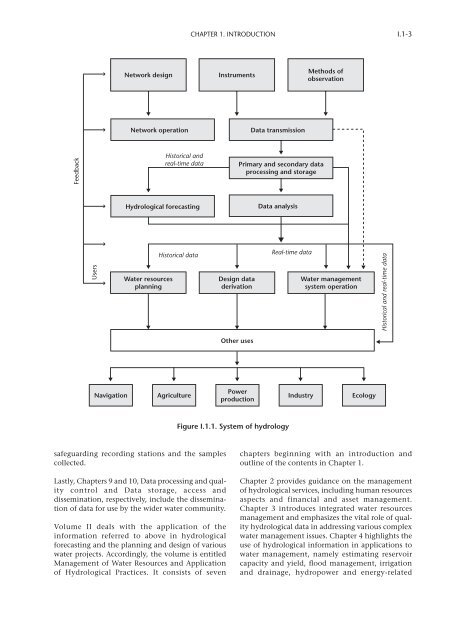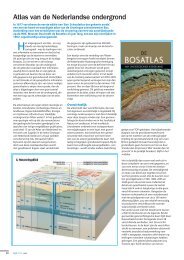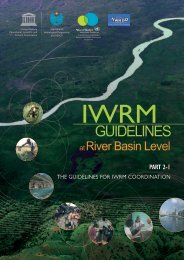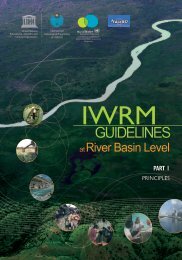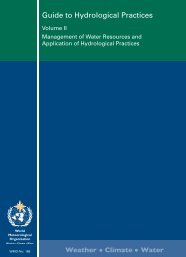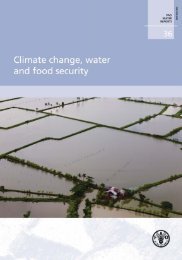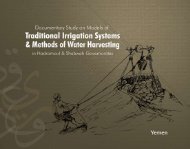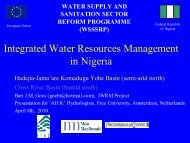- Page 1: Guide to Hydrological Practices Vol
- Page 4 and 5: WMO-No. 168 © World Meteorological
- Page 7 and 8: CONTENTS PREFACE ..................
- Page 9 and 10: CONTENTS CHAPTER 4. EVAPORATION, EV
- Page 11 and 12: CONTENTS ix Page 7.4 Preparation fo
- Page 13: CONTENTS xi Page 9.8 Validation and
- Page 17: ACKNOWLEDGEMENTS Following the expr
- Page 22 and 23: I.1-4 GUIDE TO HYDROLOGICAL PRACTIC
- Page 25 and 26: CHAPTER 2 METHODS OF OBSERVATION 2.
- Page 27 and 28: CHAPTER 2. METHODS OF OBSERVATION I
- Page 29 and 30: CHAPTER 2. METHODS OF OBSERVATION I
- Page 31 and 32: CHAPTER 2. METHODS OF OBSERVATION I
- Page 33 and 34: CHAPTER 2. METHODS OF OBSERVATION I
- Page 35 and 36: CHAPTER 2. METHODS OF OBSERVATION I
- Page 37 and 38: CHAPTER 2. METHODS OF OBSERVATION I
- Page 39 and 40: CHAPTER 2. METHODS OF OBSERVATION I
- Page 41 and 42: CHAPTER 2. METHODS OF OBSERVATION I
- Page 43 and 44: CHAPTER 2. METHODS OF OBSERVATION I
- Page 45 and 46: CHAPTER 2. METHODS OF OBSERVATION I
- Page 47 and 48: CHAPTER 2. METHODS OF OBSERVATION I
- Page 49 and 50: CHAPTER 2. METHODS OF OBSERVATION I
- Page 51 and 52: CHAPTER 2. METHODS OF OBSERVATION I
- Page 53 and 54: CHAPTER 2. METHODS OF OBSERVATION I
- Page 55 and 56: CHAPTER 2. METHODS OF OBSERVATION I
- Page 57 and 58: CHAPTER 2. METHODS OF OBSERVATION I
- Page 59 and 60: CHAPTER 2. METHODS OF OBSERVATION I
- Page 61 and 62: CHAPTER 2. METHODS OF OBSERVATION I
- Page 63 and 64: CHAPTER 2. METHODS OF OBSERVATION I
- Page 65 and 66: CHAPTER 2. METHODS OF OBSERVATION I
- Page 67 and 68: CHAPTER 2. METHODS OF OBSERVATION I
- Page 69 and 70: CHAPTER 2. METHODS OF OBSERVATION I
- Page 71 and 72:
CHAPTER 2. METHODS OF OBSERVATION I
- Page 73 and 74:
CHAPTER 2. METHODS OF OBSERVATION I
- Page 75 and 76:
Altitude Pool Threshold Pool Change
- Page 77 and 78:
CHAPTER 2. METHODS OF OBSERVATION I
- Page 79 and 80:
CHAPTER 2. METHODS OF OBSERVATION I
- Page 81 and 82:
CHAPTER 2. METHODS OF OBSERVATION I
- Page 83 and 84:
CHAPTER 2. METHODS OF OBSERVATION I
- Page 85 and 86:
CHAPTER 3 PRECIPITATION MEASUREMENT
- Page 87 and 88:
CHAPTER 3. PRECIPITATION MEASUREMEN
- Page 89 and 90:
CHAPTER 3. PRECIPITATION MEASUREMEN
- Page 91 and 92:
CHAPTER 3. PRECIPITATION MEASUREMEN
- Page 93 and 94:
N (D) CHAPTER 3. PRECIPITATION MEAS
- Page 95 and 96:
50 49 48 43 42 41 3 2 47 46 45 44 5
- Page 97 and 98:
CHAPTER 3. PRECIPITATION MEASUREMEN
- Page 99 and 100:
CHAPTER 3. PRECIPITATION MEASUREMEN
- Page 101 and 102:
CHAPTER 3. PRECIPITATION MEASUREMEN
- Page 103 and 104:
CHAPTER 3. PRECIPITATION MEASUREMEN
- Page 105 and 106:
CHAPTER 3. PRECIPITATION MEASUREMEN
- Page 107 and 108:
CHAPTER 3. PRECIPITATION MEASUREMEN
- Page 109 and 110:
CHAPTER 3. PRECIPITATION MEASUREMEN
- Page 111 and 112:
CHAPTER 3. PRECIPITATION MEASUREMEN
- Page 113 and 114:
CHAPTER 3. PRECIPITATION MEASUREMEN
- Page 115 and 116:
CHAPTER 3. PRECIPITATION MEASUREMEN
- Page 117 and 118:
CHAPTER 4 EVAPORATION, EVAPOTRANSPI
- Page 119 and 120:
CHAPTER 4. EVAPORATION, EVAPOTRANSP
- Page 121 and 122:
CHAPTER 4. EVAPORATION, EVAPOTRANSP
- Page 123 and 124:
CHAPTER 4. EVAPORATION, EVAPOTRANSP
- Page 125 and 126:
CHAPTER 4. EVAPORATION, EVAPOTRANSP
- Page 127 and 128:
CHAPTER 4. EVAPORATION, EVAPOTRANSP
- Page 129 and 130:
40 CHAPTER 4. EVAPORATION, EVAPOTRA
- Page 131 and 132:
CHAPTER 4. EVAPORATION, EVAPOTRANSP
- Page 133 and 134:
CHAPTER 4. EVAPORATION, EVAPOTRANSP
- Page 135 and 136:
CHAPTER 4. EVAPORATION, EVAPOTRANSP
- Page 137 and 138:
CHAPTER 4. EVAPORATION, EVAPOTRANSP
- Page 139 and 140:
CHAPTER 4. EVAPORATION, EVAPOTRANSP
- Page 141 and 142:
CHAPTER 4. EVAPORATION, EVAPOTRANSP
- Page 143 and 144:
CHAPTER 4. EVAPORATION, EVAPOTRANSP
- Page 145 and 146:
CHAPTER 4. EVAPORATION, EVAPOTRANSP
- Page 147 and 148:
CHAPTER 4. EVAPORATION, EVAPOTRANSP
- Page 149 and 150:
CHAPTER 5 SURFACE WATER QUANTITY AN
- Page 151 and 152:
CHAPTER 5. SURFACE WATER QUANTITY A
- Page 153 and 154:
CHAPTER 5. SURFACE WATER QUANTITY A
- Page 155 and 156:
CHAPTER 5. SURFACE WATER QUANTITY A
- Page 157 and 158:
CHAPTER 5. SURFACE WATER QUANTITY A
- Page 159 and 160:
CHAPTER 5. SURFACE WATER QUANTITY A
- Page 161 and 162:
CHAPTER 5. SURFACE WATER QUANTITY A
- Page 163 and 164:
CHAPTER 5. SURFACE WATER QUANTITY A
- Page 165 and 166:
CHAPTER 5. SURFACE WATER QUANTITY A
- Page 167 and 168:
CHAPTER 5. SURFACE WATER QUANTITY A
- Page 169 and 170:
CHAPTER 5. SURFACE WATER QUANTITY A
- Page 171 and 172:
CHAPTER 5. SURFACE WATER QUANTITY A
- Page 173 and 174:
CHAPTER 5. SURFACE WATER QUANTITY A
- Page 175 and 176:
CHAPTER 5. SURFACE WATER QUANTITY A
- Page 177 and 178:
CHAPTER 5. SURFACE WATER QUANTITY A
- Page 179 and 180:
CHAPTER 6 GROUNDWATER 6.1 GENERAL [
- Page 181 and 182:
CHAPTER 6. GROUNDWATER I.6-3 actual
- Page 183 and 184:
CHAPTER 6. GROUNDWATER I.6-5 Type o
- Page 185 and 186:
CHAPTER 6. GROUNDWATER I.6-7 labour
- Page 187 and 188:
CHAPTER 6. GROUNDWATER I.6-9 50-mm
- Page 189 and 190:
CHAPTER 6. GROUNDWATER I.6-11 Such
- Page 191 and 192:
CHAPTER 6. GROUNDWATER I.6-13 accur
- Page 193 and 194:
CHAPTER 6. GROUNDWATER I.6-15 groun
- Page 195 and 196:
80 Bedrock CHAPTER 6. GROUNDWATER I
- Page 197 and 198:
CHAPTER 6. GROUNDWATER I.6-19 Manom
- Page 199 and 200:
CHAPTER 6. GROUNDWATER I.6-21 non-l
- Page 201 and 202:
CHAPTER 6. GROUNDWATER I.6-23 in, r
- Page 203 and 204:
CHAPTER 6. GROUNDWATER I.6-25 Dutar
- Page 205 and 206:
CHAPTER 7 WATER QUALITY AND AQUATIC
- Page 207 and 208:
CHAPTER 7. WATER QUALITY AND AQUATI
- Page 209 and 210:
CHAPTER 7. WATER QUALITY AND AQUATI
- Page 211 and 212:
CHAPTER 7. WATER QUALITY AND AQUATI
- Page 213 and 214:
CHAPTER 7. WATER QUALITY AND AQUATI
- Page 215 and 216:
CHAPTER 7. WATER QUALITY AND AQUATI
- Page 217 and 218:
CHAPTER 7. WATER QUALITY AND AQUATI
- Page 219 and 220:
CHAPTER 7. WATER QUALITY AND AQUATI
- Page 221 and 222:
CHAPTER 7. WATER QUALITY AND AQUATI
- Page 223 and 224:
CHAPTER 7. WATER QUALITY AND AQUATI
- Page 225:
CHAPTER 7. WATER QUALITY AND AQUATI
- Page 228 and 229:
I.8-2 GUIDE TO HYDROLOGICAL PRACTIC
- Page 230 and 231:
I.8-4 GUIDE TO HYDROLOGICAL PRACTIC
- Page 232 and 233:
I.8-6 GUIDE TO HYDROLOGICAL PRACTIC
- Page 234 and 235:
I.8-8 GUIDE TO HYDROLOGICAL PRACTIC
- Page 236 and 237:
I.8-10 GUIDE TO HYDROLOGICAL PRACTI
- Page 238 and 239:
I.9-2 GUIDE TO HYDROLOGICAL PRACTIC
- Page 240 and 241:
I.9-4 GUIDE TO HYDROLOGICAL PRACTIC
- Page 242 and 243:
I.9-6 GUIDE TO HYDROLOGICAL PRACTIC
- Page 244 and 245:
I.9-8 GUIDE TO HYDROLOGICAL PRACTIC
- Page 246 and 247:
I.9-10 GUIDE TO HYDROLOGICAL PRACTI
- Page 248 and 249:
I.9-12 GUIDE TO HYDROLOGICAL PRACTI
- Page 250 and 251:
I.9-14 GUIDE TO HYDROLOGICAL PRACTI
- Page 252 and 253:
I.9-16 GUIDE TO HYDROLOGICAL PRACTI
- Page 254 and 255:
I.9-18 GUIDE TO HYDROLOGICAL PRACTI
- Page 256 and 257:
I.9-20 GUIDE TO HYDROLOGICAL PRACTI
- Page 258 and 259:
I.9-22 GUIDE TO HYDROLOGICAL PRACTI
- Page 260 and 261:
I.9-24 GUIDE TO HYDROLOGICAL PRACTI
- Page 262 and 263:
I.9-26 GUIDE TO HYDROLOGICAL PRACTI
- Page 265 and 266:
CHAPTER 10 DATA STORAGE, ACCESS AND
- Page 267 and 268:
CHAPTER 10. DATA STORAGE, ACCESS AN
- Page 269 and 270:
CHAPTER 10. DATA STORAGE, ACCESS AN
- Page 271 and 272:
CHAPTER 10. DATA STORAGE, ACCESS AN
- Page 273 and 274:
CHAPTER 10. DATA STORAGE, ACCESS AN
- Page 275 and 276:
CHAPTER 10. DATA STORAGE, ACCESS AN
- Page 277 and 278:
CHAPTER 10. DATA STORAGE, ACCESS AN
- Page 279 and 280:
CHAPTER 10. DATA STORAGE, ACCESS AN
- Page 281 and 282:
CHAPTER 10. DATA STORAGE, ACCESS AN
- Page 283 and 284:
CHAPTER 10. DATA STORAGE, ACCESS AN
- Page 285 and 286:
CHAPTER 10. DATA STORAGE, ACCESS AN
- Page 287 and 288:
CHAPTER 10. DATA STORAGE, ACCESS AN
- Page 289 and 290:
CHAPTER 10. DATA STORAGE, ACCESS AN
- Page 291 and 292:
CHAPTER 10. DATA STORAGE, ACCESS AN
- Page 293:
ANNEX ABBREVIATIONS AND ACRONYMS 2D


